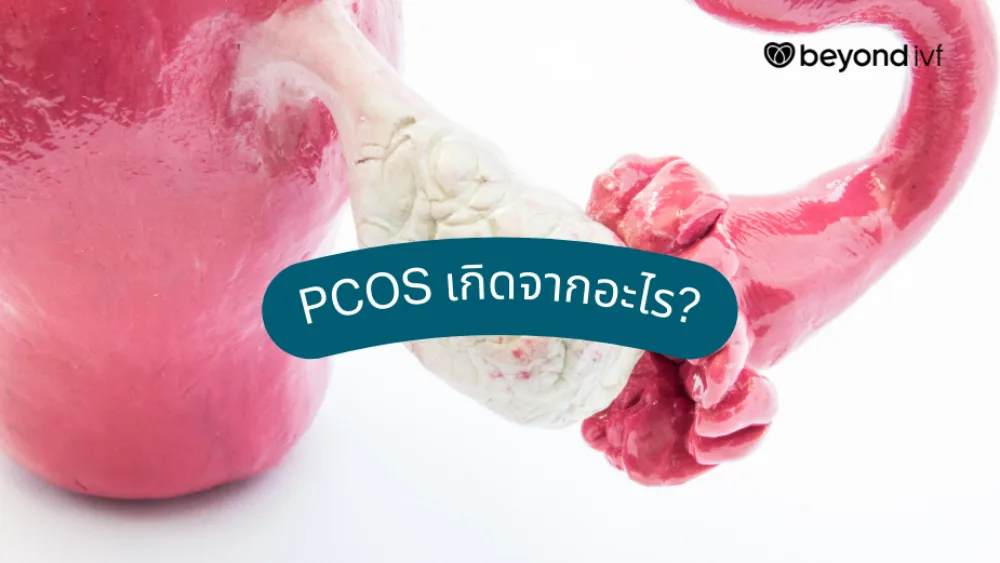Normally, many women may experience irregular or inconsistent menstrual cycles. However, you might not realize that this could be an early warning sign of Polycystic Ovary Syndrome (PCOS) — a condition that is one of the leading causes of infertility without you even knowing it.
You might be wondering what to do if you're diagnosed with PCOS, especially if you're trying to conceive. What lifestyle changes should you make? What treatment options are available?
These are important questions, and understanding the condition is the first step toward managing it effectively and improving your chances of getting pregnant.
Understanding Polycystic Ovary Syndrome (PCOS)
Polycystic Ovary Syndrome (PCOS) is an endocrine disorder, meaning a hormonal imbalance in the body involving estrogen, progesterone, androgens (male hormones), and insulin. It is one of the most common causes of infertility in women of reproductive age.
The condition is characterized by the presence of multiple cysts in the ovaries. These cysts can interfere with normal ovarian function, leading to irregular or infrequent menstrual periods. Women with PCOS may also experience enlarged ovaries with multiple cysts, excessive body or facial hair (hirsutism), and more severe acne than usual.

What Causes Polycystic Ovary Syndrome (PCOS)?
Causes of Polycystic Ovary Syndrome (PCOS)
The exact cause of PCOS is still unclear. It may be related to genetic factors or dysfunctions in multiple systems within the body—such as the pituitary gland, ovaries, adrenal glands, or a combination of other factors. These include:
-
Hormonal Imbalances:
-
PCOS can be caused by an imbalance of hormones, particularly excessive insulin and elevated levels of male hormones (androgens such as testosterone).
-
Signs of high androgens in women include oily skin, severe acne, male-pattern baldness, or excessive hair growth in areas like the chest, lower abdomen, arms, and legs.
-
In some women, prolactin levels may also be elevated. Prolactin is the hormone that stimulates breast milk production during pregnancy, and high levels may contribute to the development of multiple ovarian cysts.
-
-
Other Contributing Factors:
-
Environmental influences, ethnicity, and genetics can also play a role.
-
If someone in your family, such as a mother or sister, has had PCOS, your risk may be higher as well.
-
These combined factors may contribute to the onset of PCOS.

Recognizing the Symptoms of Polycystic Ovary Syndrome (PCOS)
Menstrual periods may be abnormal—too light, too heavy, or irregular. Some women may not menstruate for several consecutive months. The cycle may be longer than 35 days, with fewer than 8 periods per year.
Significant Weight Gain
Weight may increase significantly, often leading to abdominal obesity. This type of weight gain can affect insulin function, which contributes to the development of PCOS.
Physical Changes from Excess Male Hormones
Changes in physical appearance may occur due to elevated androgens (male hormones), such as excess body hair in unusual places, deepening of the voice, hair thinning or hair loss (especially at the scalp), and severe acne.
Infertility
PCOS affects hormone balance, disrupting ovulation and causing difficulty in getting pregnant.
Other Symptoms
Dark patches of skin may appear in body folds, such as under the breasts, on the neck, or in the armpits—signs that may indicate insulin resistance and risk for type 2 diabetes.
Severe PCOS Complications (if left untreated):
-
Infertility: Chronic anovulation (lack of ovulation) results in the absence of viable reproductive cells. Even if pregnancy occurs, there is a higher risk of miscarriage during the first trimester due to hormonal imbalance. There may also be complications such as gestational diabetes, preeclampsia, or restricted fetal growth.
-
Increased Risk of Endometrial Hyperplasia and Cancer: Prolonged lack of ovulation can lead to the thickening of the uterine lining (endometrial hyperplasia), increasing the risk of endometrial cancer and possibly breast cancer.
When to See a Doctor
Normally, women should have an annual gynecological check-up to detect any abnormalities or conditions early, so they can be treated at the initial stage. However, in Thailand, annual check-ups are not yet widely popular. If you notice any unusual symptoms related to your reproductive system, such as abdominal pain, irregular periods, or rapid weight gain, you should see a doctor promptly.

The diagnostic process by a doctor typically involves several steps, including
-
History Taking: The doctor will ask about general symptoms, such as the duration of your menstrual cycle, frequency of periods, changes in body weight, and any other related symptoms.
-
Physical Examination: The doctor will conduct a physical examination to collect basic information, such as height, weight, and blood pressure.
-
Pelvic Examination: The doctor will check the reproductive organs in detail to look for any abnormalities or signs of disease.
-
Blood Tests: Blood tests will be performed to measure hormone levels, as abnormalities in hormone levels can indicate conditions like PCOS.
-
Ultrasound: A transvaginal ultrasound may be used to assess the ovaries and the thickness of the uterine lining. This helps the doctor determine whether the ovaries are enlarged or whether there are cysts present, aiding in the accurate diagnosis.
Complications that may arise from PCOS include
-
Infertility: It increases the risk of difficulty getting pregnant due to irregular ovulation or lack of ovulation.
-
High Blood Pressure and Cardiovascular Disease: Women with PCOS are at a higher risk of developing high blood pressure and cardiovascular diseases due to hormonal imbalances and insulin resistance.
-
Obesity and Fatty Liver Disease: The condition can increase the risk of obesity and liver inflammation, particularly due to insulin resistance.
-
Type 2 Diabetes: PCOS increases the risk of developing type 2 diabetes due to insulin resistance, where the body’s cells become less responsive to insulin.
-
Endometrial Problems: PCOS can cause issues with the uterine lining, such as abnormal bleeding, and increase the risk of developing endometrial cancer due to irregular menstruation and thickened uterine lining.

Polycystic Ovary Syndrome (PCOS) and Pregnancy
For pregnant women who have Polycystic Ovary Syndrome (PCOS), the body may have higher levels of male hormones (androgens) compared to other hormones. This hormonal imbalance can increase the risk of miscarriage and lead to complications such as gestational diabetes, preeclampsia, and premature birth. Additionally, PCOS may contribute to chronic issues in the future. Therefore, women who wish to conceive should first address and manage PCOS before trying to get pregnant.
However, women with PCOS who are aiming to become pregnant should consult with a fertility specialist. Modern medical treatments often involve assisted reproductive technologies, such as in vitro fertilization (IVF) and Intracytoplasmic Sperm Injection (ICSI), which have high success rates. Hormonal treatments are also commonly used to balance hormone levels and regulate menstrual cycles, increasing the chances of successful conception.
Treatment Approaches for Polycystic Ovary Syndrome (PCOS)
The treatment for Polycystic Ovary Syndrome (PCOS) can be approached in several ways, depending on the symptoms and other factors involved to determine the most suitable treatment. These include:
-
Medication:
Treatment with medication depends on the symptoms. For example, to address ovulation problems, Clomiphene Citrate may be prescribed to help regulate ovulation and normalize egg release. -
Surgical Treatment:
Surgery can be used to remove parts of the ovaries that produce excess testosterone, which helps restore normal ovulation. However, this method tends to be effective only in the short term. -
Other Methods:
For example, using an intrauterine device (IUD) to prevent abnormalities in the uterine lining.
The appropriate treatment should be determined by a healthcare provider based on the individual's specific condition and health goals.

Self-care methods to prevent Polycystic Ovary Syndrome (PCOS) include the following
Losing weight and controlling diet are essential because when you lose weight, the hormonal function in the body returns to normal, and menstrual cycles become more regular.
Regular exercise should be practiced.
Avoid stress, as stress can cause hormonal imbalances.
Take hormonal medications as prescribed by the doctor consistently.
Frequently Asked Questions about PCOS
-
Can people with PCOS have children?
Yes, it is still possible to conceive naturally if you have polycystic ovary syndrome (PCOS), as some months may still involve ovulation. However, in severe cases, such as when periods are absent for an extended period, the chances of conceiving naturally may be more difficult. -
Can PCOS be cured?
There is no cure for PCOS, as the exact cause is still unclear. Treatment focuses on managing symptoms, balancing hormones, and reducing male hormone levels through medications such as birth control pills. -
Can PCOS resolve on its own?
PCOS will not resolve on its own. Medical consultation and treatment are necessary for proper diagnosis and management. While it cannot be completely cured, it can be managed with appropriate care.
Conclusion
Polycystic Ovary Syndrome (PCOS) is still a common condition among Thai women. Many should not overlook it and should undergo regular pelvic exams and visits to the doctor every year. Although PCOS is one of the causes of infertility due to chronic anovulation (lack of ovulation), it is still possible to conceive if you know the proper approach and treatment.
The most popular and successful medical treatment today is assisted reproductive technology, such as in vitro fertilization (IVF) and ICSI, along with hormone regulation to restore normal menstrual cycles.
If you have concerns or are experiencing symptoms of PCOS, you can ask for more information via Line: @beyondivf






